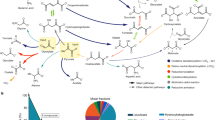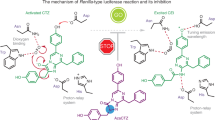Abstract
THE communication under the above title by Brown1 prompts us to record that we have been engaged on the same problem from the chemical point of view during the past few years. Our approach was based on the assumption that combined tyrosine (in a protein) could be oxidized to combined 3 : 4-dihydroxyphenylalanine (I) [R = CH2.CH(NH.COR′). CO.NHR′, where R′ is part of the protein residue], which might then undergo oxidation in either of two ways, namely: (i) direct hydroxylation of the benzene nucleus in the 6-position to give (II), (ii) oxidative elimination of R to produce hydroxyquinol (1 : 2 : 4-trihydroxybenzene) (III). In either case, a 1 : 2 : 4-trihydroxybenzene derivative would be produced. 
This is a preview of subscription content, access via your institution
Access options
Subscribe to this journal
Receive 51 print issues and online access
$199.00 per year
only $3.90 per issue
Buy this article
- Purchase on Springer Link
- Instant access to full article PDF
Prices may be subject to local taxes which are calculated during checkout
Similar content being viewed by others
References
Brown, Nature, 165, 275 (1950).
Compare Raper, Biochem. J., 21, 89 (1927).
Thiele and Winter, Annalen, 311, 341 (1900).
Compare Mitchell and Hamilton, J. Biol Chem., 178, 345 (1949).
Author information
Authors and Affiliations
Rights and permissions
About this article
Cite this article
BURTON, H., STOVES, J. Quinone Tanning in the Animal Kingdom. Nature 165, 569–570 (1950). https://doi.org/10.1038/165569b0
Issue Date:
DOI: https://doi.org/10.1038/165569b0
Comments
By submitting a comment you agree to abide by our Terms and Community Guidelines. If you find something abusive or that does not comply with our terms or guidelines please flag it as inappropriate.



